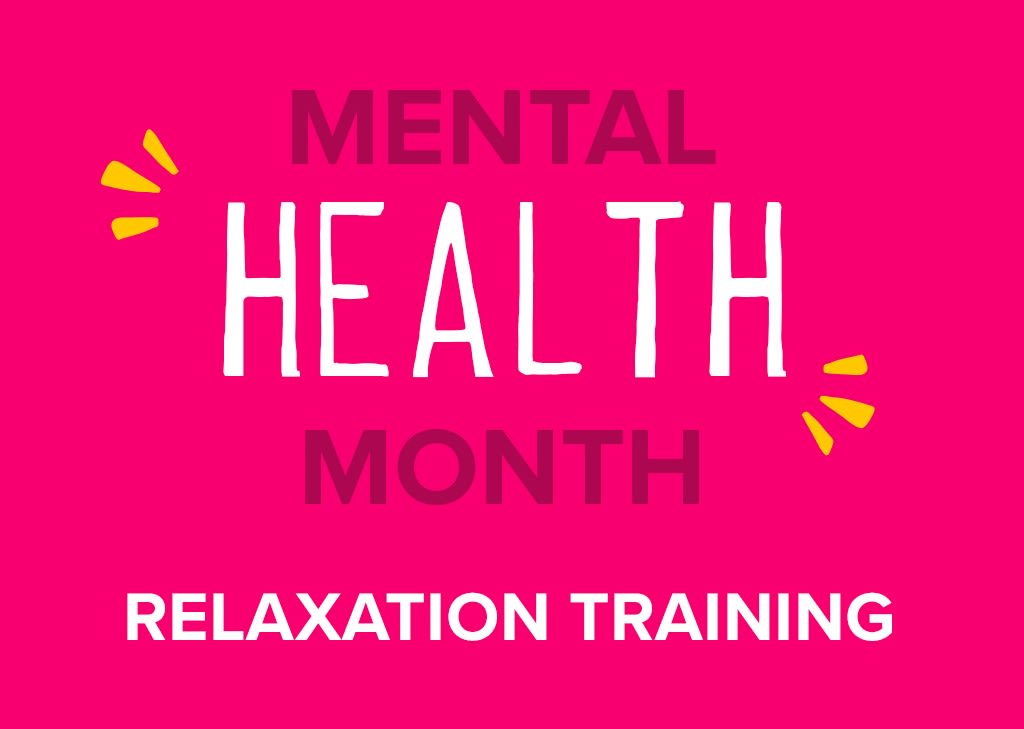Mental Health Month: Relaxation Training

October 6, 2017

October is Mental Health Month! At SWEAT, we wanted to create a series of blogs on this important topic, starting with this post! Mental Health Month is all about encouraging open dialogue about mental health and wellbeing, as well as providing you with practical tools to help you get through everyday issues or tough periods.
This week, we’re talking about relaxation training and how it can help during periods of stress and anxiety.
What is relaxation training?
When you’re faced with a situation that makes you feel stressed or anxious, your flight or fight response kicks in. Your nervous system then automatically reacts by releasing chemicals and tensing your muscles. This response is to prepare you for an emergency situation. When this response is activated regularly by stress or high levels of anxiety, this can take a toll on your body. Your muscles might be tensed to the point of causing headaches, muscle pain and fatigue.
Relaxation training aims to help relieve this muscle tension, as well as helping reduce other responses from your nervous system. Practising relaxation techniques may help to lower your blood pressure, slow down rapid breathing and help you to feel calmer.
This is another argument for why you need to listen to your body. That way, you’ll be able to identify when you need to spend some time focusing on your own needs.
How is relaxation training done?
There are different kinds of relaxation training, so you can find one that suits you best. If sore muscles or headaches are an issue for you, then progressive muscle relaxation might be a good place to start.
With progressive muscle relaxation, you tense and relax different muscle groups of your body. This can help to unwind tension, allowing a feeling of relaxation to flow through your body as you release each muscle group.
Let’s get started!
Find a quiet place away from distractions and get comfortable. You can either sit or lie down, whichever feels best. When you’re ready, start by closing your eyes and focusing on your breathing for a minute or two. Inhale through your nose, drawing the breath in through your diaphragm and releasing slowly through your mouth.
As you draw in a breath, tense the muscles in your left foot as hard as you count.
Keep breathing as normal while you hold your foot muscles tense for a count of 10.
On your next exhale, release your foot muscles so that they are completely relaxed.
Wait 20 seconds before repeating the process.
Once you’ve repeated the process, move on to the your right foot and follow the same relaxation exercise. You then gradually move up your body, from foot to leg, hand to arm and onto your abdomen, then neck and shoulders.
After you’ve tensed and relaxed each muscle group in your body, take your time opening your eyes and standing up again. Progressive muscle relaxation is all about learning what tension feels like in your body and taking steps to relax your body and mind. Relaxation training is a skill, so practising it regularly can help you manage stressful situations better.
What else can help you deal with stress?
If progressive muscle relaxation isn’t your thing, then try exploring other relaxation methods!
Here’s a couple of suggestions:
Deep breathing is a key tool for relaxation practices, so spending time focusing on using your diaphragm when you draw air in and out. This can be really helpful for calming your nervous system.
Practice mindfulness, particularly when you exercise. Mindfulness is about putting aside the worries of yesterday or tomorrow and focusing on this present moment.
Try visualisation, or guided imagery. This is where you imagine a scene where you feel at peace and try to notice as many details as possible, like what you would see, hear, smell and feel if you were there.
Yoga can also be really helpful for reducing muscle tension and to help you focus on your breathing.
Regular exercise can not only help you to release physical tension, but also give you time to clear your mind. Exercise can also help encourage your brain to release feel-good chemicals, which may leave you feeling more positive too.
Remember, different relaxation techniques will work for different people, so it might take some time to find what is right for you. Don’t be afraid to try some of the relaxation methods mentioned above if you are feeling overwhelmed. You might even find a combination of techniques fits your situation better.
This is just one tool you can use to help you manage stress and anxiety. Over the next few weeks, we’ll cover a number of mental health matters, so make sure you check back each week!

A more empowered you starts with Sweat, and our editorial team is here to bring you the latest fitness tips, trainer recommendations, wellbeing news, nutritional advice, nourishing recipes and free workouts.
* Disclaimer: This blog post is not intended to replace the advice of a medical professional. The above information should not be used to diagnose, treat, or prevent any disease or medical condition. Please consult your doctor before making any changes to your diet, sleep methods, daily activity, or fitness routine. Sweat assumes no responsibility for any personal injury or damage sustained by any recommendations, opinions, or advice given in this article.
Wellbeing